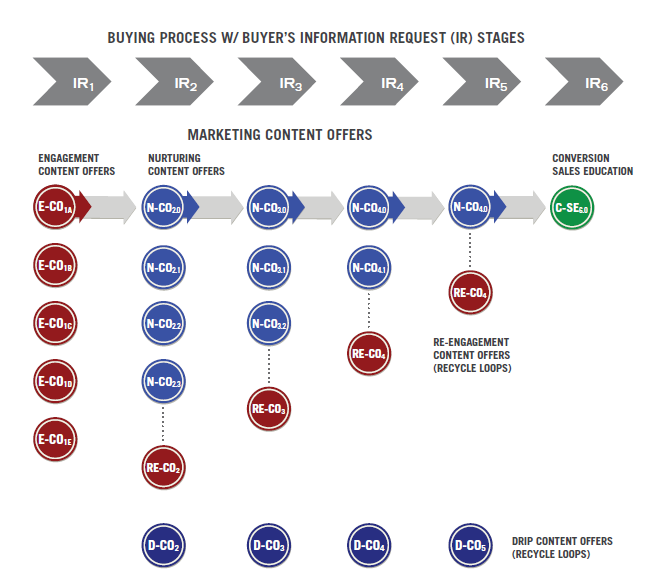Do any of these statements sound familiar?
- “We have a lot of great content, and we generate a ton of leads but sales accepts only a few as sales-ready.”
- “We can’t keep up with all the campaign requests we get from sales.”
- “We have white papers for every buying stage, but we just can’t get enough people to download them.”
If one or more of those struck a chord with you, it might be time for a Content Map.
A Content Map plots your buyer personas against your buyer journey for their information needs at each stage. A general representation of this concept is below:
 Of course, the first step is to understand your buyer journey and the personas involved.
Of course, the first step is to understand your buyer journey and the personas involved.
From your insights into your buyers you should know for each stage of the buying cycle:
- Which personas are involved at each stage
- What their information needs are at each stage
- Where they get this information
Personas
Recently Demand Gen Report 2015 B2B Buyer’s Survey reported that:
- 48% said of buyers’ purchase process included one to three people
- 35% said four to six people
- 14% cited seven to 10 influencers
- 3% (Bless their hearts) cited 10 or more purchase influencers
So…the odds are pretty good you don’t have “a” buyer. You have several, and their information needs, trigger events and content consumption habits vary. They may not all be involved at every stage, but you need to provide them content when it counts.
Information Needs
Early stage buyers may not rush to download your 20-page white paper, as beautifully written as it may be. Find out what your buyers need to know and match the format accordingly to deliver that information. You’re probably going to need more than you think. You can’t count on the buyer acting on the first opportunity to consume the content. Things happen, people are busy and re-delivery of the same content will only get you so far.
Channels
At different stages of the buying cycle, buyers look to different sources for information. Maybe they learn of best practices from LinkedIn groups or narrow their selection sets via vendor web sites. Do your research and you’ll have your content in the right places. Make sure your program is listening for and responding to interactions across channels. The same Demand Gen Report survey reported that 82% of buyers said they are using more sources to research and evaluate purchases. With your content map in hand, you’ll be able to counter each of the issues expressed above.
“We have a lot of great content, and we generate a ton of leads but sales accepts only a few as sales-ready.”
You’ll now understand that this might have happened because you were great at producing early stage content and had a one-and-done, single stage qualification process to pass on every downloader of your “great content.” Your content map will make sure you’re appropriately gauging buying behavior based on the level of content consumed, and only passing on the most qualified buyers to sales.
“We can’t keep up with all the campaign requests we get from sales.”
Since you’ll now understand the buying process as well as anyone and have the foundation for a perpetual demand generation program, there should be less chasing after the latest sales idea. Sales will see more and more qualified leads that come through the program and should be engaged to inform and adjust the overall approach, not creating one-off campaigns for marketing to execute.
“We have white papers for every buying stage, but we just can’t get enough leads to download them.”
With your content map you’ll know that white papers aren’t the only content type and perhaps aren’t the right format for your earlier stage buyers. But if you have deeper level content in a white paper that does get downloads, you’ll know that even though the quantity might be fewer, those buyers are further along in their process as well.
A content map is essential to a high-performing demand generation program. With this valuable asset, you’re now ready to start on the path to delivering real, sustainable results.
This article was syndicated from Business 2 Community: Is Your Content Marketing Missing The Mark?
More Sales & Marketing articles from Business 2 Community:




